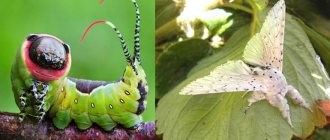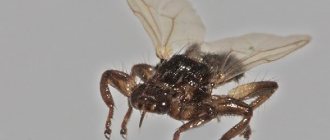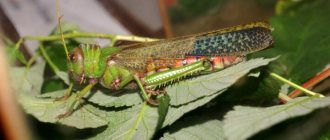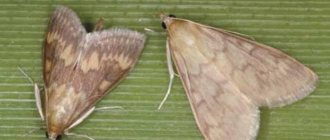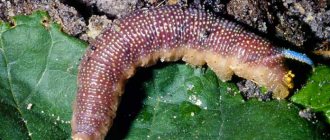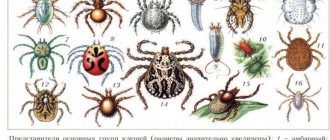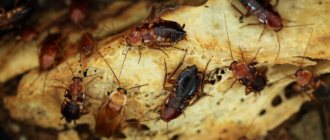Various caterpillars (photo)
Habitat
The limited mobility of caterpillars does not facilitate their movement over long distances. In most cases, insects lead a terrestrial lifestyle, but there are also species that live in water.
All caterpillars are divided into two main groups: hidden and leading a free lifestyle. The former practically do not appear on the surface and live in the bark or in the ground away from sunlight. The latter are found on plants and are active during the daytime.
Habitat
In nature, many insects and animals feed on caterpillars. This is due to their high protein content. Therefore, the color of insects living on plants has a camouflage color, which allows them to blend in with the surface of the leaves. Poisonous butterfly larvae are characterized by a frightening bright body shade.
Among those who eat caterpillars:
- wasps;
- spiders;
- birds;
- reptiles.
To protect themselves from attacks from predators, some butterfly larvae are capable of producing a whistle and protruding from their body a fork-shaped gland of a red-orange hue, which secretes mucus with a pungent odor.
Description of caterpillars
Body of a caterpillar.
A caterpillar is a stage of insect development that develops from an egg to a pupa, from which the butterfly itself subsequently emerges.
A caterpillar at this stage can live for several days, weeks or even months, it all depends on the species.
Size, shade and even feeding habits are characteristics that vary by species. But the structure is the same - only the presence or absence of a process in the form of a horn or several can differ.
| Torso | There are some tiny species, but there are also huge ones. The torso consists of the head, thoracic, abdominal, and limbs. |
| Head | Consists of 6 segments that have fused and formed a capsule. There is a forehead, cheeks, and a foramen magnum. Some have antennae or horns. |
| Mouth | Caterpillars eat their entire lives. They have a well-developed oral apparatus, with teeth at the top for biting and inside for chewing. |
| Eyes | Primitive consisting of one lens. Most often there are 5-6 pairs of eyes, located one after the other. |
| Corpuscle | Consists of several segments that are separated by grooves. It is soft and very mobile. Ends with the anus. |
| Respiratory organ | The stigma spiracle is located on the chest. Those individuals that live in water have tracheal gills. |
| Limbs | Almost all of them have 3 pairs of limbs on the chest and 5 pairs of false legs on the abdominal region, which have a sole and a claw. |
| Cover | Even those caterpillars that look monochromatic are covered with hairs; they do not exist naked. But the presence of processes or bristles depends on the species. |
The life cycle and all stages of transformation are a real miracle.
Caterpillar molt
At the stage of development and preparation for pupation, the caterpillar eats a lot, so it needs to change its skin. This process is called molting and occurs more than once. Depending on the species and gender, the number can be from 2 to 40 times, but most often 5-7.
Molting caterpillars.
Lifestyle and habitat
Caterpillar on leaves.
Caterpillars most often live on land, but there are a few specimens underwater. Some species are adapted for both options. Conventionally, caterpillars are divided into 2 types according to the type of existence: secretive and free.
The way of life also depends on this: there are those that actively move, but also individuals that prefer not to move far from food sources. Due to their short lifespan, they are most often unpretentious to living conditions.
Caterpillar nutrition
Almost all caterpillars feed on plants. Only a few individuals are predators that eat insects (aphids) and attack weakened representatives of their genus. There are 4 main types:
Polyphages . They eat any plant food. These are the majority.
Oligophages. They prefer a specific species or family of plants.
Monophages. Species that feed only on one specific plant.
Xylophagous. They only eat the wood of some trees, there are very few of them.
Do caterpillars eat leaves and meat of small insects?
Caterpillars find food by smell and taste. Most of these creatures feed in one place until the entire tree or bush is eaten. If all the food is gone and there is no food left nearby, the larva pupates underfed. A small butterfly will later emerge from it.
Caterpillars not only feed on flowers, leaves and wood; some eat meat. Cases of predation can be considered an exception to the rule rather than a pattern. Predation occurs during cohabitation and when there is a lack of food. Weak and sick individuals become food. Some herbivorous representatives attack other caterpillars in the presence of plant food (narrow-winged moth, raspberry moth).
Blueberry individuals sometimes eat aphids. The larvae, found in Hawaii, eat insects. They use silk thread traps to catch snails.
Caterpillars to fight
Many of the insects are agricultural pests. They eat cultivated crops - fruits, vegetables, shrubs and trees. If you have to fight them, then you need to use some of these methods.
Mechanical
This is the collection, shaking off or cutting of caterpillars or clutches. This also includes adhesive-based fishing belts or traps with liquids for bait.
Biological
These are natural enemies that eat caterpillars. They can be attracted to the site. These include birds and some insects.
Chemical
The use of poisonous drugs that act effectively, but have a number of contraindications and difficulties.
Folk
The use of infusions and decoctions is used in cases where the infection is not very severe.
Structure and characteristics
The caterpillar consists of a body, head, abdomen, eyes, a pair of legs and a breathing apparatus. On the head there is an oral apparatus with a mass of small teeth that are involved in the process of food consumption. The legs of caterpillars have special claws that are attached to the surface of the leaf on which the caterpillar is located.
There is a wide range of larval colors: for example, there are green caterpillars, yellow, pink, beige and so on.
Transformation of larvae into butterflies
Metamorphosis of a caterpillar.
By definition, caterpillars are larvae that turn into butterflies, absolutely everything. Some species are one- or two-day-old butterflies that live only to lay eggs.
But voracious animals do not always complete their life cycle. They may be eaten or become victims of parasites.
There are insects that look like caterpillars, but they are not. They are called false caterpillars. These are the larvae of some beetles, worms, wasps or ants.
Sawfly false caterpillars.
Appearance and features
Photo: What a caterpillar looks like
The most common caterpillars are:
- large white caterpillar (Pieris brassicae), the adults of which are called cabbage white butterflies. The caterpillars accumulate high concentrations of mustard oil in their diet, and their bright, spotted bodies alert potential predators to their unpleasant taste;
- small turtle caterpillar (Aglais urticae). Living together benefits caterpillars because they can combine their bodies in unison, acting as one large organism in an attempt to ward off predators. Eventually, individual caterpillars crawl away separately to pupate. Tortoiseshell caterpillars can be seen from May to June, with adults potentially active throughout the year;
- comma caterpillar (Polygonia c-album). The caterpillars change color quite a bit throughout their larval stage, but the older caterpillars are the most distinctive. Scorched orange and black hatchlings develop a white "saddle" mark, reminiscent of a bird's shedding, which deters predators;
- bloody bear caterpillar (Tyria jacobaeae). Growing up to 28mm, these black and yellow caterpillars are very distinctive and easy to identify as they look like they are wearing a rugby shirt;
- silver hole caterpillar (Phalera bucephala). This black and yellow caterpillar reaches 70 mm in length and has hairs that are irritating to humans and good at protecting themselves from predators;
- caterpillar of the pale tuberculate moth (Calliteara pudibunda). The caterpillars can grow up to 45mm and reach full size in about two months. The stubble on the caterpillar's body is known to cause skin irritation in humans. The adults are a beautiful gray moth with comb-like antennae;
- caterpillar of the maple moth (Acronicta aceris). It is an urban species, distinguished by bright orange hair and black and white diamond patterns along the back;
- caterpillar of the Acronicta psi. After hatching from the eggs, which only take a week to hatch, the caterpillars grow to 40mm within about thirty days. Gray caterpillars can be found from July to early October. The whitish adults are active from mid-May to August. Their yellow stripe serves as camouflage on plant stems.
Now you know what a caterpillar looks like. Let's find out where this insect is found.
Poisonous species
Caterpillars often serve as food for other animals. To avoid becoming someone's food, they have many adaptations. Some species use protective or deterrent coloration, while others secrete a secretion with an unpleasant odor. Some of them used poison.
Scales, hairs and needles hidden under the skin of some caterpillars can cause lepidopterism or caterpillar dermatitis. It is manifested by inflammation, swelling, itching and redness of the contact points and can have serious consequences. The larvae of the oak, gypsy and marching silkworms, megalopygis operaculus, hickory dipper, Saturnia io, spiderwort, etc. are poisonous.
The lonomia caterpillar is considered one of the most dangerous. It is found only in South America. Poisoning with its secretion even has its own name - lonomyasis. Contact with lonomia obliqua and lonomia achelous species can result in severe internal bleeding and death. The caterpillars live on fruit trees, and their “victims” are often plantation workers.
Social structure and reproduction
Caterpillars are ready to become butterflies from birth. Even in the smallest caterpillar, freshly hatched from a tiny egg, bundles of cells for organs such as antennae, wings, legs and genitals are already primed and destined to become adults. Called imaginal discs (being flat and round), they are unable to grow and develop due to the constant leaching of juvenile hormone.
As the larva feeds, its intestine, muscles and some other internal organs grow and develop, but the imaginal discs are temporarily suppressed and remain dormant. The caterpillar behaves like a free-living, feeding, growing, but developmentally suppressed embryo.
When it reaches a critical size, the molting hormone, ecdysone, is released. It sheds its skin several times in response to ecdysone, each time forming a new instar (stage), but the juvenile hormone keeps it in the caterpillar, preventing further development until its concentration approaches full size and the concentration of the latter decreases.
In the fifth and final instar of the caterpillar, the imaginal discs are already beginning to emerge from forced dormancy and grow. Juvenile hormone now falls below threshold and the next surge of ecdysone stimulates transformation into pupa. The flattened imaginal discs begin to develop unhindered. Each folds into a concave dome, then takes the shape of a sock. The center of each disc is designed to become a limb—the tip of a paw or the tip of a wing.
Much of the caterpillar's plump mass is processed into adult features, which merge into the inner shell of the pupa. At this stage, the interior consists mainly of a nutrient soup that nourishes the embryonic imaginal discs as they complete their delayed development. The final surge of ecdysone occurs amid nearly zero juvenile hormone—and stimulates the emergence of the adult butterfly to mate, disperse, and lay eggs.

